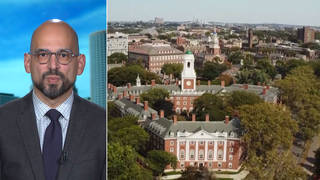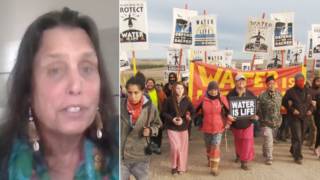
Topics
Guests
- Laurie Cantilloboard member and volunteer with Humane Borders.
- Eddie Canalesdirector of the South Texas Human Rights Center.
A massive heat dome is starting to engulf the southern United States this week. It could grow to be one of the worst in the region’s history, breaking records for intensity and longevity and impacting some 50 million people in Florida, Texas, New Mexico, Arizona, Southern California and Nevada. Heat domes are a key part of heat waves and have become hotter and longer due to climate change, making heat the leading cause of weather-related death in the United States. Along the Southwest border, more than 100 migrants have already died from heat this year amid the Biden administration’s continued crackdown on asylum seekers. We hear from Laurie Cantillo, a board member and volunteer with Humane Borders, which works to maintain water stations for migrants crossing the Sonoran Desert and Organ Pipe Cactus National Monument along the Arizona-Mexico border, as well as Eddie Canales, director of the South Texas Human Rights Center, who condemns the U.S.’s policy of migrant deterrence as inhumane and ineffective and says that “migrant deaths will continue to happen until we have a policy [to receive] workers … [and] to deal with the lack of human rights in their home [countries].”
Transcript
AMY GOODMAN: This is Democracy Now!, democracynow.org, The War and Peace Report. I’m Amy Goodman, with Juan González, as we turn now to the massive heat dome that is descending on the southern United States this week, could be one of the worst in the region’s history, breaking records for intensity and longevity and impacting some 50 million people in Florida, Texas, New Mexico, Arizona, Southern California and Nevada. Heat domes are a key part of heat waves, have become hotter and longer due to climate change. Heat is now the leading cause of weather-related death in the United States.
In a minute, we’ll look at the heat’s impact on workers and prisoners in Texas, which just banned mandatory water breaks, but we begin along the Southwest border, where more than a hundred migrants have already died from heat this year. Last week alone, the Border Patrol officials reported 13 deaths and 226 rescues for dehydration and other heat-related causes. Democracy Now! spoke to Humane Borders board member, volunteer Laurie Cantillo about the group’s work to maintain water stations for migrants crossing the Sonoran Desert and Organ Pipe Cactus National Monument along the Arizona and Mexico border.
LAURIE CANTILLO: Many of these people are crossing without any idea what lies ahead, how inhospitable the conditions are. There’s no shade. Oftentimes they’re traveling with no water, no food, no hats. There’s small children with them. I observed on my last water run a woman who was carrying a 3- to 4-month-old infant on her back. So, you know, these are just really harsh conditions, and I’m very concerned about the toll that it’s going to take on human health.
AMY GOODMAN: This comes as thousands of migrants are languishing in camps that often have no running water as they struggle to book appointments to enter the United States through a new government smartphone app, and Texas has started to install what it calls a floating barrier on the Rio Grande that has raised concern about drowning risks for people crossing the river.
For more, we go to South Texas, where the heat indexes could reach 115 degrees Fahrenheit this week. We’re joined in Falfurrias by Eddie Canales, director of the South Texas Human Rights Center.
Eddie, welcome back to Democracy Now!, under terrible circumstances. Explain what this heat wave and U.S. policy and Texas policy means for migrants when it comes to access to water and life itself.
EDDIE CANALES: Well, thank you for having me on, explaining the extreme heat that has been around already here for close to a month in terms of heat index reaching 115 to 120 degrees.
The center provides water, you know, in terms of for the last nine years, 10 years, we have provided water stations. It’s a guessing game in terms of where we can provide the water stations for migrants that are coming through. This year in Brooks County, there has been 22 confirmed deaths, in terms of recoveries of human remains and bodies. And, you know, we’re dealing with the climate change, and this is an example in terms of the extreme heat that we’re facing here in South Texas. You know, people are having to deal with that aspect of it. And we have access in some of the ranches in Brooks County that have been very gracious in allowing some of the ranches to provide some of the water.
But the other day, we encountered a situation in one of the surrounding counties, where we had placed some water stations along a route there, that’s right out one of the counties that is surrounding next to Brooks County, and 12 of those water stations were missing, were gone. And we had just, within the last couple of weeks here, checked those water stations, and they were fine. They’ve been there for close to nine years. And we checked with the Texas Department of Transportation. They had nothing to do with the removal of those water stations.
So, we’re investigating the fact that other, in that county, ranchers have previously taken water stations that we’ve had present, and we’re just dealing and continuing our investigation regarding, you know, who was — why would you want to remove water stations that are life-saving for people? And I think it represents a sentiment that is being — prevails here in the state of Texas by the governor in terms of really, really having — doubling up on a lot of the enforcement and spending a lot of the state funds to try to deter people from coming. That’s not the case. There is no deterrence. You know, migration is not going to be stopped anytime soon.
So, we need to deal with that situation in a more compassionate and a more economic sense, what makes economics. People are coming here to work. People are coming here to go to the big cities and do some of the work that is not being done by anybody else. So, what process do we have beyond an enforcement-only approach? Placing a buoy, placing a — and I think that extends out to some of the ranchers in that area, in the Jim Hogg area, in terms of where — why the water stations would be removed, you know, and why construction workers can’t take a break in this heat.
So, it’s a reality that we have. We need to — the extreme heat is having an effect. Migrant deaths will continue to happen until we have a policy that makes sense in terms of receiving workers that are coming through, essential workers that are coming through, to provide and contribute to this economy in this country, and then also, at the same time, you know, deal with the lack of human rights from their home country.
JUAN GONZÁLEZ: And, Eddie Canales, could talk about this new initiative of Governor Greg Abbott to put a floating barrier in the Rio Grande to prevent people from coming through?
EDDIE CANALES: Well, we just had — I mean, over the last past year, there has been a lot of — in the Eagle Pass-Piedras Negras area, there has been a lot of drownings. And so, I don’t know how effective. It’s just still an enforcement-only approach, and none of the efforts that Governor Abbott has really undertaken have been effective to any degree. The buoy is a thousand feet long. I just don’t see how that’s going to deter people. They’re just going to move to a more different — a different area, more dangerous area, in terms of trying to get through.
The process right now has slowed down considerably in terms of 50% less apprehensions at the border. But still, people are still coming through undetected or uninspected in that regards. Yesterday, we received 12 calls out at the center here. And 12 of those calls, only one of them had used the CBP One form. And the other 11 people, families, we had to — you know, were reporting that those people are missing. Those people have disappeared.
So the issue is still the broken system. There’s no — the only approach is an enforcement-only approach. And that sentiment goes all the way into, you know, the ranchers, some of the ranchers. And we’re still following up in terms of our investigation in terms of what happened. Some were still present on that trail that we have, but at least 12 of those water stations were missing. So, I don’t see the enforcement efforts by the state, the governor, having any effect whatsoever right now on deterring anybody.
AMY GOODMAN: Well, we’re going to continue to look at the governor’s policies. Eddie Canales, thanks so much for being with us, director of the South Texas Human Rights Center.













Media Options